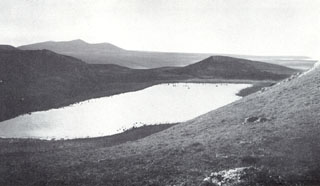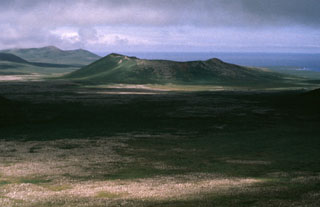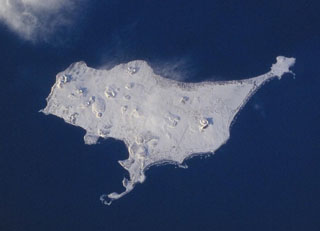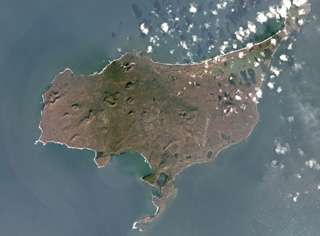

The Global Volcanism Program has no activity reports available for St. Paul Island.
The Global Volcanism Program has no Weekly Reports available for St. Paul Island.
The Global Volcanism Program has no Bulletin Reports available for St. Paul Island.
This compilation of synonyms and subsidiary features may not be comprehensive. Features are organized into four major categories: Cones, Craters, Domes, and Thermal Features. Synonyms of features appear indented below the primary name. In some cases additional feature type, elevation, or location details are provided.
Synonyms |
||||
| Saint Paul Island | ||||
Cones |
||||
| Feature Name | Feature Type | Elevation | Latitude | Longitude |
| Black Bluffs | Tuff cone | 3 m | 57° 7' 12" N | 170° 16' 34" W |
| Bogoslof Hill | Shield volcano | 168 m | 57° 10' 43" N | 170° 17' 42" W |
| Crater Hill | Pyroclastic cone | 139 m | 57° 11' 3" N | 170° 20' 1" W |
| Fox Hill | Pyroclastic cone | 129 m | 57° 10' 41" N | 170° 23' 18" W |
|
Hill 404
Low Hill |
Pyroclastic cone | 122 m | 57° 11' 47" N | 170° 18' 43" W |
| Hutchinson Hill | Shield volcano | 29 m | 57° 14' 46" N | 170° 6' 47" W |
| Lake Hill | Pyroclastic cone | 67 m | 57° 10' 44" N | 170° 14' 42" W |
|
North Hill
Pot Hill |
Pyroclastic cone | 111 m | 57° 12' 31" N | 170° 18' 41" W |
| Otter Island | Pyroclastic cone | 65 m | 57° 2' 48" N | 170° 24' 35" W |
| Polovina Hill | Pyroclastic cone | 126 m | 57° 10' 52" N | 170° 11' 37" W |
| Ridge Hill | Pyroclastic cone | 142 m | 57° 10' 57" N | 170° 22' 35" W |
| Rush Hill | Pyroclastic cone | 187 m | 57° 11' 17" N | 170° 24' 4" W |
| Walrus Island | Pyroclastic cone | 4 m | 57° 10' 50" N | 169° 56' 30" W |
Craters |
||||
| Feature Name | Feature Type | Elevation | Latitude | Longitude |
| Cone Hill | Fissure vent | 154 m | 57° 10' 31" N | 170° 21' 43" W |
|
|
||||||||||||||||||||||||||||
There is data available for 1 confirmed Holocene eruptive periods.
[ 1943 ] Uncertain Eruption
| Episode 1 | Eruption | Several km SW of St. Paul | |||
|---|---|---|---|---|
| 1943 - Unknown | Evidence from Unknown | |||
1280 BCE ± 40 years Confirmed Eruption
| Episode 1 | Eruption | West side (Fox Hill) | ||||||||||||||||||||||||||||||||||
|---|---|---|---|---|---|---|---|---|---|---|---|---|---|---|---|---|---|---|---|---|---|---|---|---|---|---|---|---|---|---|---|---|---|---|---|
| 1280 BCE ± 40 years - Unknown | Evidence from Isotopic: 14C (uncalibrated) | ||||||||||||||||||||||||||||||||||
|
List of 5 Events for Episode 1 at West side (Fox Hill)
| |||||||||||||||||||||||||||||||||||
There is no Deformation History data available for St. Paul Island.
There is no Emissions History data available for St. Paul Island.
 Lake-filled Crater Hill on the western side of St. Paul is one of many craters across the island. Caribou can be seen wading along the shores of the lake. The largest of the Pribilof Islands, St. Paul consists of a 110 km2 area of coalescing small edifices with a central scoria cone. The Fox Hill lava flow at the far western end of the island is estimated to be only a few thousand years old.
Lake-filled Crater Hill on the western side of St. Paul is one of many craters across the island. Caribou can be seen wading along the shores of the lake. The largest of the Pribilof Islands, St. Paul consists of a 110 km2 area of coalescing small edifices with a central scoria cone. The Fox Hill lava flow at the far western end of the island is estimated to be only a few thousand years old. Crater Hill, on the western side of St. Paul Island, is one of many cones on the 110 km2 island. The complex crater is 200 m deep and has several smaller cones within it, as well as a 50-m-thick lava flow.
Crater Hill, on the western side of St. Paul Island, is one of many cones on the 110 km2 island. The complex crater is 200 m deep and has several smaller cones within it, as well as a 50-m-thick lava flow.  A Space Shuttle image of St. Paul Island shows Northeast Point to the upper right, Reef Point at the bottom-center, and Southwest Point to the left. Snow-covered Big Lake lies SW of Northeast Point, Bogoslof Hill near the center of the island, and Rush Hill is the cone along the NW coast. Rush Hill produced lava flows from NE-trending fissures. The 110 km2 island is the largest of the Pribilof Islands and contains more than a dozen scoria cones and associated lava flows.
A Space Shuttle image of St. Paul Island shows Northeast Point to the upper right, Reef Point at the bottom-center, and Southwest Point to the left. Snow-covered Big Lake lies SW of Northeast Point, Bogoslof Hill near the center of the island, and Rush Hill is the cone along the NW coast. Rush Hill produced lava flows from NE-trending fissures. The 110 km2 island is the largest of the Pribilof Islands and contains more than a dozen scoria cones and associated lava flows. St. Paul island, one of the Pribilof Islands in the Bering Sea, is composed of overlapping scoria cones, spatter cones, and lava flows, shown in this October 2017 Planet Labs satellite image monthly mosaic (N is at the top; this image is approximately 23 km across). Cones include the westernmost Rush hill, Black Bluffs scoria cone on the southern peninsula, the Bogoslof Hill complex in the center, and North Hill along the northern coastline.
St. Paul island, one of the Pribilof Islands in the Bering Sea, is composed of overlapping scoria cones, spatter cones, and lava flows, shown in this October 2017 Planet Labs satellite image monthly mosaic (N is at the top; this image is approximately 23 km across). Cones include the westernmost Rush hill, Black Bluffs scoria cone on the southern peninsula, the Bogoslof Hill complex in the center, and North Hill along the northern coastline.Maps are not currently available due to technical issues.
The following 5 samples associated with this volcano can be found in the Smithsonian's NMNH Department of Mineral Sciences collections, and may be availble for research (contact the Rock and Ore Collections Manager). Catalog number links will open a window with more information.
| Catalog Number | Sample Description | Lava Source | Collection Date |
|---|---|---|---|
| NMNH 116061 | Olivine Basalt | -- | -- |
| NMNH 116062 | Basalt | -- | -- |
| NMNH 62988-1 | Lava | -- | -- |
| NMNH 62988-2 | Lava | -- | -- |
| NMNH 88358 | Volcanic Bomb | -- | -- |
| Alaska Volcano Observatory (Link to St. Paul Island) | The Alaska Volcano Observatory (AVO) is a joint program of the U.S. Geological Survey (USGS), the Geophysical Institute of the University of Alaska Fairbanks (UAFGI), and the State of Alaska Division of Geological and Geophysical Surveys (ADGGS). AVO was formed in 1988, and uses federal, state, and university resources to monitor and study Alaska's hazardous volcanoes, to predict and record eruptive activity, and to mitigate volcanic hazards to life and property. |
| Copernicus Browser | The Copernicus Browser replaced the Sentinel Hub Playground browser in 2023, to provide access to Earth observation archives from the Copernicus Data Space Ecosystem, the main distribution platform for data from the EU Copernicus missions. |
| MIROVA | Middle InfraRed Observation of Volcanic Activity (MIROVA) is a near real time volcanic hot-spot detection system based on the analysis of MODIS (Moderate Resolution Imaging Spectroradiometer) data. In particular, MIROVA uses the Middle InfraRed Radiation (MIR), measured over target volcanoes, in order to detect, locate and measure the heat radiation sourced from volcanic activity. |
| MODVOLC Thermal Alerts | Using infrared satellite Moderate Resolution Imaging Spectroradiometer (MODIS) data, scientists at the Hawai'i Institute of Geophysics and Planetology, University of Hawai'i, developed an automated system called MODVOLC to map thermal hot-spots in near real time. For each MODIS image, the algorithm automatically scans each 1 km pixel within it to check for high-temperature hot-spots. When one is found the date, time, location, and intensity are recorded. MODIS looks at every square km of the Earth every 48 hours, once during the day and once during the night, and the presence of two MODIS sensors in space allows at least four hot-spot observations every two days. Each day updated global maps are compiled to display the locations of all hot spots detected in the previous 24 hours. There is a drop-down list with volcano names which allow users to 'zoom-in' and examine the distribution of hot-spots at a variety of spatial scales. |
|
WOVOdat
Single Volcano View Temporal Evolution of Unrest Side by Side Volcanoes |
WOVOdat is a database of volcanic unrest; instrumentally and visually recorded changes in seismicity, ground deformation, gas emission, and other parameters from their normal baselines. It is sponsored by the World Organization of Volcano Observatories (WOVO) and presently hosted at the Earth Observatory of Singapore.
GVMID Data on Volcano Monitoring Infrastructure The Global Volcano Monitoring Infrastructure Database GVMID, is aimed at documenting and improving capabilities of volcano monitoring from the ground and space. GVMID should provide a snapshot and baseline view of the techniques and instrumentation that are in place at various volcanoes, which can be use by volcano observatories as reference to setup new monitoring system or improving networks at a specific volcano. These data will allow identification of what monitoring gaps exist, which can be then targeted by remote sensing infrastructure and future instrument deployments. |
| Volcanic Hazard Maps | The IAVCEI Commission on Volcanic Hazards and Risk has a Volcanic Hazard Maps database designed to serve as a resource for hazard mappers (or other interested parties) to explore how common issues in hazard map development have been addressed at different volcanoes, in different countries, for different hazards, and for different intended audiences. In addition to the comprehensive, searchable Volcanic Hazard Maps Database, this website contains information about diversity of volcanic hazard maps, illustrated using examples from the database. This site is for educational purposes related to volcanic hazard maps. Hazard maps found on this website should not be used for emergency purposes. For the most recent, official hazard map for a particular volcano, please seek out the proper institutional authorities on the matter. |
| IRIS seismic stations/networks | Incorporated Research Institutions for Seismology (IRIS) Data Services map showing the location of seismic stations from all available networks (permanent or temporary) within a radius of 0.18° (about 20 km at mid-latitudes) from the given location of St. Paul Island. Users can customize a variety of filters and options in the left panel. Note that if there are no stations are known the map will default to show the entire world with a "No data matched request" error notice. |
| UNAVCO GPS/GNSS stations | Geodetic Data Services map from UNAVCO showing the location of GPS/GNSS stations from all available networks (permanent or temporary) within a radius of 20 km from the given location of St. Paul Island. Users can customize the data search based on station or network names, location, and time window. Requires Adobe Flash Player. |
| DECADE Data | The DECADE portal, still in the developmental stage, serves as an example of the proposed interoperability between The Smithsonian Institution's Global Volcanism Program, the Mapping Gas Emissions (MaGa) Database, and the EarthChem Geochemical Portal. The Deep Earth Carbon Degassing (DECADE) initiative seeks to use new and established technologies to determine accurate global fluxes of volcanic CO2 to the atmosphere, but installing CO2 monitoring networks on 20 of the world's 150 most actively degassing volcanoes. The group uses related laboratory-based studies (direct gas sampling and analysis, melt inclusions) to provide new data for direct degassing of deep earth carbon to the atmosphere. |
| Large Eruptions of St. Paul Island | Information about large Quaternary eruptions (VEI >= 4) is cataloged in the Large Magnitude Explosive Volcanic Eruptions (LaMEVE) database of the Volcano Global Risk Identification and Analysis Project (VOGRIPA). |
| EarthChem | EarthChem develops and maintains databases, software, and services that support the preservation, discovery, access and analysis of geochemical data, and facilitate their integration with the broad array of other available earth science parameters. EarthChem is operated by a joint team of disciplinary scientists, data scientists, data managers and information technology developers who are part of the NSF-funded data facility Integrated Earth Data Applications (IEDA). IEDA is a collaborative effort of EarthChem and the Marine Geoscience Data System (MGDS). |